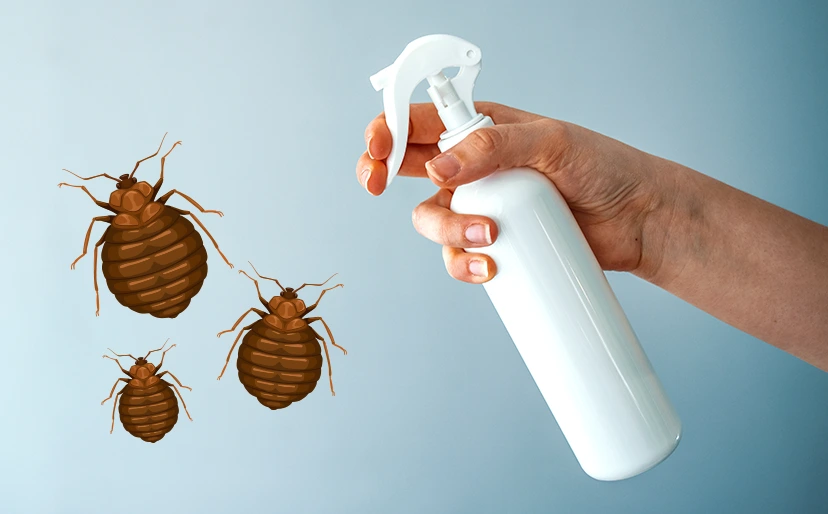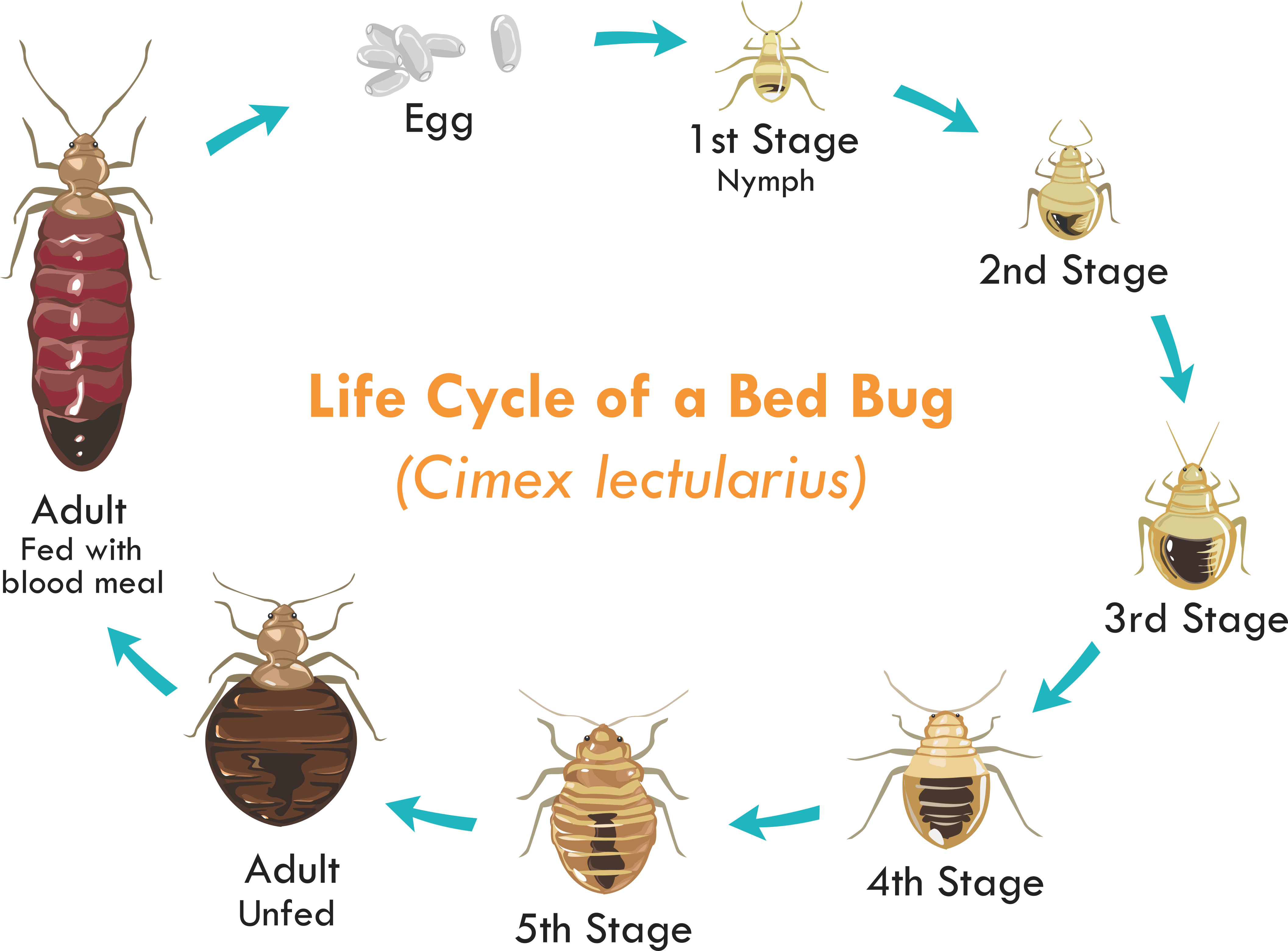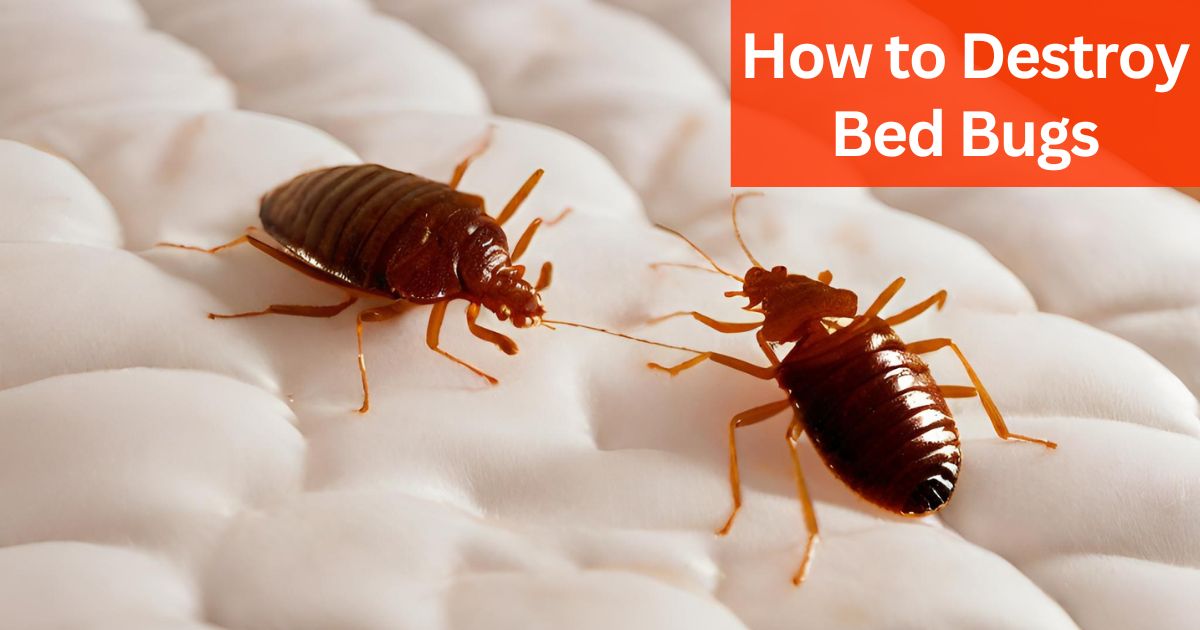To destroy bed bugs, use a combination of methods including vacuuming, heat treatment, and insecticide sprays. It’s essential to be thorough and persistent in your approach to completely eradicate the infestation.
Dealing with bed bugs can be a frustrating and overwhelming experience. These tiny pests can quickly multiply and spread, making them difficult to eliminate. However, with careful planning and the right strategies, you can effectively destroy bed bugs and prevent future infestations.
In this guide, we’ll explore the most effective methods for getting rid of bed bugs, covering everything from DIY solutions to professional treatments. By following these tips, you can reclaim your home from these persistent pests and enjoy a bed bug-free environment once again. Let’s dive in and learn how to tackle this common household nuisance.

Credit: www.planetnatural.com
Understanding Bed Bugs
Understanding Bed Bugs: Before learning how to destroy bed bugs, it’s crucial to know more about these tiny pests.
Identifying Bed Bugs:
Identifying Bed Bugs: Bed bugs are small, reddish-brown insects typically about the size of an apple seed.
Bed Bug Behavior:
Bed Bug Behavior: Bed bugs are nocturnal creatures that feed on the blood of humans and animals while they sleep.
Bed Bug Behavior: They are excellent hitchhikers and can travel from place to place by clinging onto clothing or luggage.

Credit: www.bluebeetlepest.com
Preventing Bed Bug Infestation
Bed bugs are a nuisance that nobody wants to deal with. Preventing bed bug infestations is crucial to protecting your home and ensuring peace of mind. By being proactive and taking preventative measures, you can reduce the risk of bed bug infestations. Here are some key strategies to help you prevent bed bug infestation:
Inspecting For Bed Bugs
Regularly inspect your home for any signs of bed bugs. Check your mattress, bed frame, furniture, and clothing for live bugs, bloodstains, or fecal matter, which are all indicators of a bed bug infestation.
Protecting Your Home
- Encase your mattress and box spring in a bed bug proof cover to prevent bed bugs from infesting these areas.
- Reduce clutter in your home to eliminate hiding spots for bed bugs.
- Vacuum frequently, especially around the bed and furniture to remove any bed bugs or eggs that may be present.
Precautions While Travelling
- Inspect your hotel room for any signs of bed bugs before unpacking your belongings.
- Keep your luggage off the floor and use luggage racks or suitable stands instead.
- Upon returning home, immediately wash and dry all clothing on the highest heat setting to kill any potential bed bugs that may have hitched a ride.
Natural Remedies For Bed Bugs
Combat bed bugs naturally using essential oils like lavender, tea tree, or peppermint. Vacuum and steam-clean bedding and furniture regularly. Encase mattresses and pillows in bed bug-proof covers. Declutter and eliminate hiding spots. Use diatomaceous earth or silica gel to desiccate bed bugs.
Seek professional help if infestation persists.
Introduction:
Dealing with a bed bug infestation can be incredibly frustrating and distressing. These tiny pests can quickly multiply and cause discomfort, bites, and sleepless nights. While professional pest control may be the most effective solution, there are several natural remedies you can try to eliminate bed bugs from your home. In this article, we will explore four common natural remedies for bed bugs: Heat Treatment, Freezing Treatment, Diatomaceous Earth, and Tea Tree Oil.
Heat Treatment:
One of the most effective ways to destroy bed bugs is through heat treatment. Bed bugs cannot survive in high temperatures, so exposing infested items or areas to heat is an excellent natural remedy. You can use various heat sources, such as a steamer, hairdryer, or a clothes dryer set on high heat, to kill bed bugs and their eggs. Ensure that the heat reaches all cracks, crevices, and hiding spots where bed bugs may be hiding. Remember to prioritize safety precautions when using heat sources to prevent accidents and damage.
Freezing Treatment:
Another natural remedy for eliminating bed bugs is through freezing treatment. Bed bugs are susceptible to extreme cold temperatures, making freezing an effective method to eradicate them. Items that cannot be exposed to high heat can be placed in a freezer for several days to kill bed bugs. Ensure that the freezer reaches or maintains a temperature of 0°F (-18°C) or below for at least four days. Additionally, you can use commercially available products designed specifically for freezing treatment, such as cold sprays, to target and eliminate bed bugs in specific areas.
Diatomaceous Earth:
Diatomaceous Earth is a natural product that can help combat a bed bug infestation. This fine powder is made from the remains of diatoms, tiny aquatic organisms, and is safe to use around humans and pets. Diatomaceous Earth works by dehydrating the bed bugs, leading to their ultimate demise. Sprinkle the powder in areas where bed bugs may be present, such as cracks, crevices, and along baseboards. Ensure that the powder is dry and undisturbed to maximize its efficiency. Regularly reapply the powder as necessary until the infestation is completely eliminated.
Tea Tree Oil:
Tea Tree Oil possesses natural insecticidal properties and can help eliminate bed bugs. Mix a few drops of tea tree oil with water in a spray bottle and thoroughly spray infested areas, including mattresses, furniture, and baseboards. Bed bugs dislike the strong scent of tea tree oil, making it an effective repellent. Furthermore, tea tree oil can suffocate and kill these pests upon contact. Repeat the application every few days until the bed bug infestation is resolved. Remember to exercise caution when using tea tree oil, as it can be toxic to pets if ingested.
Chemical Treatments For Bed Bugs
Chemical treatments are one of the most effective ways to eliminate bed bugs from a home. When dealing with a bed bug infestation, using chemical treatments can help eradicate these pests and prevent future infestations. There are several types of chemical treatments that can be used, including insecticides, sprays, dusts, and foggers.
Insecticides
Insecticides are chemical substances specifically designed to kill insects. They are available in various forms, including liquid concentrates, aerosol sprays, and dust formulations. Insecticides work by targeting the nervous system of bed bugs, causing paralysis and ultimately death. When using insecticides, it’s crucial to follow the manufacturer’s instructions carefully to ensure safe and effective application.
Sprays
Sprays are a common and convenient form of chemical treatment for bed bugs. They can be applied directly to bed bug-infested areas such as mattresses, bed frames, and baseboards. Some sprays are designed to provide residual protection, creating a barrier that prevents bed bugs from returning. However, it’s essential to choose a spray specifically labeled for bed bug control and use it according to the recommended application guidelines.
Dusts
Dusts are another effective option for treating bed bug infestations. They are typically applied to cracks, crevices, and voids where bed bugs hide and breed. Dusts work by adhering to the bed bugs’ outer shell, leading to dehydration and death. When using dusts, it’s important to apply a thin, uniform layer and avoid over-application to prevent inhalation or unnecessary exposure.
Foggers
Foggers, also known as bug bombs, are aerosol cans that release insecticidal fog when activated. They are designed to fill an enclosed space with a pesticide mist, reaching areas where bed bugs may be hiding. However, foggers should be used with caution as they can pose health risks if not used correctly. It’s crucial to carefully read and follow the directions on the fogger label to ensure safe and effective application.
Professional Extermination
Professional extermination is often the best solution for severe bed bug infestations. Skilled exterminators have the expertise and tools necessary to eradicate these stubborn pests effectively. When considering professional extermination, it’s crucial to know when to call professionals and how to choose the right bed bug exterminator. Let’s delve into these essential considerations to help you eradicate bed bugs from your home.
When To Call Professionals
If you’re dealing with a widespread bed bug infestation that has persisted despite DIY efforts, it’s time to seek professional help. Additionally, if you’re unable to identify the extent of the infestation or locate all the hiding spots of the bed bugs, it’s best to consult with an expert in bed bug extermination to ensure thorough eradication.
Choosing A Bed Bug Exterminator
When selecting a bed bug exterminator, consider factors such as their experience in dealing with bed bug infestations, the treatment methods they use, and their overall reputation. Look for exterminators who specialize in bed bug removal and have a track record of successful treatments. Additionally, make sure they are licensed and have the necessary certifications to carry out bed bug extermination services.
Preparing Your Home For Treatment
Before starting any bed bug treatment, it is essential to properly prepare your home. By following these steps, you can help increase the effectiveness of the treatment and eliminate those pesky pests for good.
Clearing Clutter
Clearing clutter is an important step in preparing your home for bed bug treatment. Bed bugs love to hide in cluttered areas, making it more difficult to reach them with treatment. Take the time to declutter your home, removing any unnecessary items or belongings that may provide hiding spots for bed bugs.
- Remove piles of clothing, books, magazines, or any other items that may be cluttering your living space.
- Pay special attention to areas such as closets, under the bed, and behind furniture, as these are common hiding spots for bed bugs.
- Consider organizing your belongings in sealed plastic containers to prevent future infestations.
Washing And Drying Infested Items
One of the most effective ways to eliminate bed bugs from infested items is by washing and drying them at high temperatures. Bed bugs cannot survive extreme heat, so this step can help kill any remaining bugs and their eggs.
- Gather all infested clothing, bedding, curtains, and other washable items.
- Separate infested items from non-infested ones to prevent spreading the infestation.
- Wash infested items in hot water, ideally at a temperature of 140°F (60°C) or above.
- After washing, transfer the items to the dryer and dry them on the highest heat setting for at least 30 minutes.
- Make sure to thoroughly clean the washing machine and dryer afterwards to prevent any remaining bed bugs from infesting future loads.
Sealing Cracks And Gaps
Sealing cracks and gaps is another crucial step in preparing your home for bed bug treatment. By sealing these entry points, you can prevent bed bugs from re-infesting your living space and ensure the success of the treatment.
- Inspect your home for cracks, gaps, and crevices where bed bugs may be hiding or entering from.
- Use caulk or sealant to fill in any gaps around baseboards, windowsills, electrical outlets, and pipes.
- Install door sweeps to seal the gap between doors and the floor.
- Repair any damaged or torn window screens to prevent bed bugs from entering through them.
Implementing The Treatment
Implementing the Treatment: When it comes to getting rid of bed bugs, effective treatment methods play a crucial role in ensuring complete eradication. The key is to implement the treatment properly to target these pesky pests.
Localized Treatment
One method to combat bed bugs is through localized treatment. This includes focusing on specific areas where bed bugs are prevalent, such as beds, furniture, and cracks in walls.
- Use pesticides labeled for bed bug control
- Apply diatomaceous earth to cracks and crevices
- Steam clean infested areas to kill bed bugs
Whole-house Treatment
To ensure comprehensive elimination, a whole-house treatment must be conducted. This involves treating the entire living space to address any hidden bed bugs that may have spread throughout the home.
- Vacuum thoroughly to remove bed bugs and eggs
- Seal up cracks and crevices to prevent reinfestation
- Professional pest control treatment may be necessary
Preventing Future Bed Bug Infestations
Implementing proactive measures can help prevent future bed bug infestations. Here are some key strategies you can follow:
Regular Inspection And Cleaning
Schedule regular inspections of your living space to detect bed bugs early.
- Vacuum frequently to remove bed bugs and their eggs.
- Wash bedding and clothing in hot water to kill bed bugs.
- Use a protective cover on your mattress and box spring.
Proper Storage
Store items properly to minimize hiding spots for bed bugs.
- Limit clutter to reduce potential bed bug hiding places.
- Seal cracks and crevices in walls, furniture, and floors.
- Avoid bringing used furniture into your home without inspection.
Awareness And Vigilance
Stay vigilant to prevent bed bugs from infiltrating your home.
- Educate yourself about bed bug signs and behaviors.
- Inspect second-hand items before bringing them home.
- Monitor for any signs of bed bugs regularly.

Credit: www.ohiogotbugs.com
Frequently Asked Questions For How To Destroy Bed Bugs?
How Do Bed Bugs Infest Homes?
Bed bugs can infest homes through used furniture, luggage, or clothing. They also spread through close contact with infested areas.
What Are The Signs Of Bed Bug Infestation?
Signs of bed bug infestation include red bites, bloodstains on sheets, and a musty odor in the room.
How To Prevent Bed Bug Infestations?
To prevent bed bug infestations, regularly vacuum your home, inspect used furniture, and keep your belongings off the floor when traveling.
Can I Eliminate Bed Bugs Without Professional Help?
While it’s possible to eliminate bed bugs on your own, professional help can ensure a more thorough and effective treatment.
Conclusion
Effectively getting rid of bed bugs requires a comprehensive approach that includes thorough cleaning, vacuuming, and laundering of infested areas, as well as the use of chemical treatments or professional pest control services. By following the steps outlined in this blog post, you can successfully combat these pesky pests and restore peace and comfort to your home.
Remember, persistence is key when dealing with bed bugs, so stay vigilant and take action as soon as you spot any signs of infestation.
Related posts:

I’m MD Tanvir, and I bring years of expertise gained from working closely with pest control companies to the forefront. My journey in the industry has inspired me to launch Bug Battler, a platform aimed at equipping people with the know-how to combat pests autonomously. Through Bug Battler, I aim to empower individuals with practical insights to tackle pest infestations effectively.

